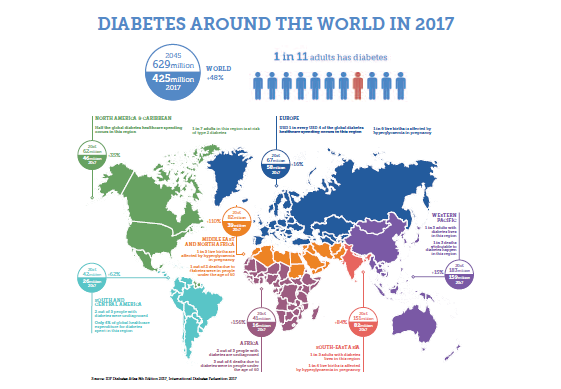Professor Nam H. Cho, President of the International Diabetes Federation (IDF) shares his expert views on the rise of diabetes across the globe
Diabetes continues to rise in prevalence across the globe. The International Diabetes Federation (IDF) estimates that there are nearly half a billion (425 million) people currently living with diabetes around the world.(1)
The numbers are vast – almost too vast to comprehend. If diabetes were a country, it would be bigger than the United States and behind only India and China in terms of its population. A combination of factors including physical inactivity, poor diet, rapid urbanisation and an ageing population are adding to the numbers living with diabetes.
Between 5 and 10% of all diabetes is Type 1 where people cannot produce sufficient insulin. The remaining 90-95% of the global diabetes burden is Type 2 diabetes, where people cannot properly use the insulin they produce.
Alarmingly, four in five people with diabetes live in low- and middle-income countries, where adequate resources for diabetes management and prevention are scarce. Half of the people currently living with diabetes are unaware of their disease, resulting in a higher risk of harmful and costly complications. Diabetes is a leading global cause of cardiovascular disease, a leading cause of blindness, of kidney failure and of lower-limb amputation.
Diabetes belongs to the top ten leading causes of death globally. In 2017, IDF estimated that diabetes was responsible for four million deaths, with half of them on average occurring prematurely before the age of 60.(1) The main causes of death among people with diabetes result from cardiovascular and renal complications.
Diabetes has negative implications for human development and the achievement of global development goals. Preventable deaths from diabetes and the loss of the workforce due to its complications are detrimental to economies worldwide. IDF estimates that the global direct healthcare costs from diabetes reached $727 billion in 2017. (1) If we include the indirect costs, the economic impact of diabetes exceeds $1trillion.(2) Governments worldwide are struggling to meet the cost of diabetes care and the financial burden will continue to expand due to the growing number of people affected. Health systems in many countries are unable to provide effective diabetes care, due to limited resources and a shortage of trained health professionals.
If not addressed, diabetes threatens to overwhelm healthcare systems and hinder economic growth in many countries. We clearly need a robust and more dynamic response from all sectors of society.
There is strong evidence that investing in diabetes prevention, education and care is a cost-effective way to tackle diabetes and its complications. In most cases, Type 2 diabetes could be prevented through lifestyle change and the promotion of healthier environments. The earlier someone is diagnosed and given treatment or taught how to care for their diabetes the more chance they will have to live a long and healthy life.
Much can be done to promote knowledge exchange and understanding of recent scientific advances to help drive policy change to ensure that new solutions relating to the detection and treatment of diabetes are available, accessible and affordable to all. Health professionals in primary healthcare should be adequately and appropriately trained about diabetes prevention and care and provided with the necessary screening tools and diabetes medications.
As part of the 2030 Agenda for Sustainable Development, the member states of the United Nations set an ambitious target to reduce premature mortality from NCDs – including diabetes – by one-third; provide access to affordable essential medicines; and achieve universal health coverage, all by 2030.
Effectively addressing the burden of diabetes does not just happen. It is the result of a collective consensus, commitment and public investment in interventions that are affordable, cost-effective and based on the best available evidence.
As the world’s largest civil society organisation serving to advance diabetes care, prevention and a cure, IDF is calling for all nations around the globe affected by the diabetes pandemic to work towards the full implementation of the Sustainable Development Goals and strengthen awareness of diabetes to create a brighter future for generations to come.
References
- International Diabetes Federation. IDF Diabetes Atlas, 8th edition. International Diabetes Federation, 2017. Available at: http://www.diabetesatlas. org/.
- Bommer C., Heesemann E., Sagalova V., et al. The global economic burden of diabetes in adults aged 20-79 years: a cost-of-illness study. Lancet Diabetes Endocrinol 2017; 5: 423-30.
Professor Nam H. Cho
President
International Diabetes Federation (IDF)













